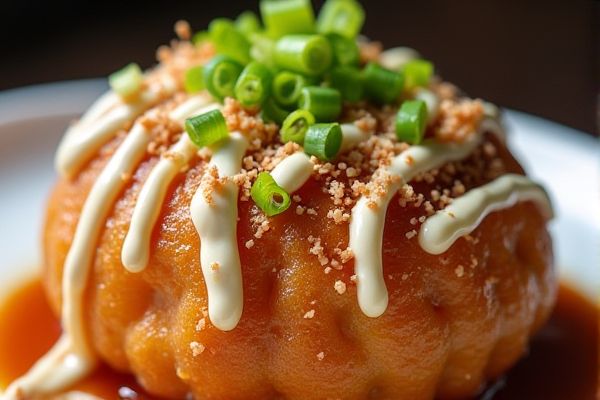
Takoyaki from Gyu-Kaku features tender octopus pieces nestled inside golden, crispy batter balls, topped with savory takoyaki sauce, creamy mayo, bonito flakes, and vibrant green onions, delivering a flavorful and visually appealing Japanese street food experience.
Equipments
- Takoyaki pan
- Mixing bowl
- Whisk
- Ladle
- Takoyaki picks or skewers
- Measuring cups
- Measuring spoons
- Squeeze bottles (for sauce and mayo)
- Tongs
- Serving plate
Ingredients
- 1 cup all-purpose flour
- 2 large eggs
- 1 1/4 cups dashi stock
- 1/2 teaspoon soy sauce
- 1/2 teaspoon salt
- 4 oz cooked octopus, diced
- 1/4 cup tenkasu (tempura scraps)
- 2 tablespoons pickled ginger, minced
- 2 tablespoons green onions, thinly sliced
- 1/4 cup takoyaki sauce
- 1/4 cup Japanese mayonnaise
- 1/4 cup bonito flakes
- 2 tablespoons aonori (dried seaweed flakes)
When preparing your takoyaki batter, use fresh dashi stock to achieve the authentic umami flavor essential to this Japanese street food. Ensure the octopus is cooked and diced into bite-sized pieces to maintain tenderness inside the crispy exterior. Incorporate tenkasu and pickled ginger evenly for added texture and a burst of savory taste. Use squeeze bottles for precise application of takoyaki sauce and Japanese mayonnaise to create the perfect topping balance. Your takoyaki from the Gyu-Kaku copycat menu will deliver a deliciously authentic experience with these key ingredients and careful preparation.
Instructions
- Preheat takoyaki pan over medium heat and lightly grease each mold.
- In a mixing bowl, whisk together flour, eggs, dashi stock, soy sauce, and salt until smooth.
- Pour batter into each mold, filling them to the top.
- Add a piece of diced octopus, a pinch of tenkasu, some pickled ginger, and green onions to each mold.
- Let cook until edges begin to set, then use takoyaki picks or skewers to turn each ball 90 degrees.
- Continue turning balls as they cook, forming a round shape and ensuring even browning on all sides.
- Cook until golden and crisp on the outside, about 4-5 minutes total.
- Transfer finished takoyaki to a serving plate using tongs.
- Drizzle with takoyaki sauce and Japanese mayonnaise using squeeze bottles.
- Sprinkle with bonito flakes, aonori, and additional green onions.
- Serve immediately.
Substitution
Takoyaki from Gyu-Kaku can be replicated at home using a takoyaki pan to achieve the signature crispy outside and tender inside texture. If octopus is unavailable, cooked shrimp or squid can serve as a flavorful substitute without compromising authenticity. When dashi stock is difficult to find, you can use a light chicken broth or water mixed with a bit of soy sauce for a similar umami base. To enhance your presentation, use squeeze bottles for evenly drizzling takoyaki sauce and mayo on the finished balls. Your takoyaki picks or skewers will help turn the batter during cooking to ensure a uniform golden crust.
Tips
Ensure your takoyaki batter is smooth and free of lumps for even cooking and texture. Do not overcrowd the takoyaki pan molds; this helps the batter cook evenly and allows you to flip the balls easily. Use a well-greased pan and keep the heat at medium to achieve a crispy golden exterior without burning the batter. When turning the takoyaki, be patient and rotate them gradually to form a perfect round shape and to cook the octopus thoroughly inside.
Nutritions
Takoyaki from Gyu-Kaku offers a balanced nutritional profile with protein-rich octopus providing essential amino acids and low-fat content. The batter made from all-purpose flour and eggs contributes carbohydrates and moderate protein, while dashi stock adds umami flavor without significant calories. Toppings like takoyaki sauce, Japanese mayonnaise, bonito flakes, and aonori enhance taste and provide small amounts of fats, vitamins, and minerals. Your serving delivers a delicious combination of macronutrients and micronutrients ideal for a satisfying snack or light meal.
Storage
Store any leftover takoyaki in an airtight container to maintain crispness and refrigerate promptly within two hours of cooking. When reheating, use a takoyaki pan or oven at medium heat to restore the golden, crispy texture without making the batter soggy. Your takoyaki will retain its flavor best if consumed within 1-2 days after storage.
Variation or Alternatives
You can switch diced cooked octopus with shrimp or diced squid for a seafood variation that keeps the traditional texture. Substitute dashi stock with vegetable broth to create a milder, vegetarian-friendly batter base. Use sriracha mayo instead of Japanese mayonnaise to add a spicy kick, enhancing the flavor profile without overpowering the other ingredients. For a fun twist, try adding finely chopped cheese inside each batter mold before cooking for a creamy surprise.
Allergies
Takoyaki from Gyu-Kaku contains common allergens such as eggs, wheat (gluten), soy (from soy sauce), and seafood (octopus and bonito flakes), which may cause allergic reactions in sensitive individuals. If you have allergies to any of these ingredients, especially shellfish or gluten, it's important to avoid this dish or consult with the restaurant staff before ordering. Cross-contamination risks may also be present due to the preparation methods.
Why this recipe?
Gyu-Kaku's Takoyaki features crispy golden exteriors paired with soft, flavorful octopus-filled centers, delivering an authentic taste of Japanese street food. The perfect blend of savory sauce, mayonnaise, and bonito flakes creates a harmonious flavor profile that keeps customers coming back. Making a copycat version allows you to recreate this unique culinary experience at home, impressing your guests with a beloved, crowd-pleasing appetizer. Your efforts will capture the deliciousness and texture that make Gyu-Kaku's Takoyaki a standout menu item.
